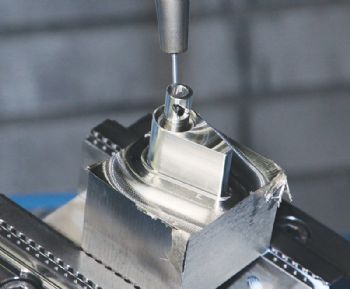
A high-end manufacturer of medium- to high-volume CNC machined components, Aylesbury-based CNF Precision Engineering recently purchased two seats of HyperMill CAM software from Open Mind Technologies (
www.openmind-tech.com) to support two recently installed Matsuura five-axis machining centres.
These machines were bought to undertake prototype and development applications, the aim being to attract new customers with this type of work and turn it into longer-term high-volume production business.
To get the best out of the 32-pallet Matsuura MAM72-35V and the latest MX520, CNF knew that it needed to upgrade its CAM software with a more-capable solution, but the company that had been supplying CAM software to CNF for over a decade could not meet the need for an advanced five-axis solution.
Following extensive research and numerous trials, CNF selected HyperMill as being the most comprehensive solution.
The company operates 24/7 with a workload that is 75% volume production and 25% prototype and small-run work; its customers are in the aerospace, medical, scientific, electronics and automotive sectors, with parts mainly machined from steel, stainless steel and aluminium.
CNF’s managing director, Neil Fearnley, said: “We looked at upgrading our software with the previous CAM supplier, but licensing issues, cost and limited five-axis cycles forced us to investigate other CAM packages.
“It was one of the best things we have done, as HyperMill has been outstanding for our business.
During the demo and early implementation stages, we quickly recognised that the software allowed us to easily manipulate tool-paths and extract geometries; moreover, its comprehensive five-axis purpose-designed cycles mean that programming is fast — and the collision avoidance is outstanding.”
CNF bought its first seat of HyperMill in October 2015; a second seat followed in time for the delivery of the new Matsuura MX520. CNF now has three programmers for its two seats of HyperMill.
New CAM benefits

Highlighting the recent growth at the company and how HyperMill has contributed, production manager Mark Baron says: “I used to spend 25hr a week programming as many as four complex jobs. Using HyperMill, I now spend the same amount of time programming 10 jobs; and as a department we can program over 30 complex jobs a week.
“When we first started with HyperMill, our programming times were immediately 20-30% shorter. The saving is now more like 60%, as we have become more proficient with the strategies — and we will get faster still.”
The improved programming times have been attributed to strategies such as ‘3-D arbitrary stock roughing’, which has reduced programming for roughing operations from 1-2hr to less than 20min in most instances.
“The ability to manipulate tool step-over with this cycle has also reduced machining times by 20-30%,” says Mr Baron.
“Additionally, the 3-D chamfer cycle recognises the shape of the part and contours the component with a chamfer tool with complete collision avoidance. This capability has also drastically reduced programming times when finishing parts.”
Mr Baron also highlights the benefits of the roughing module in HyperMill’s MAXX Machining performance package. “We have a throughput of 3,500-6,000 milled parts a month, and more than half of these require rough-machining.
“Historically, we used a lot of indexable cutting tools, such as 20mm-diameter end mills, but the depth of cut and step-over are limited by the insert dimensions.
“We have now applied the roughing strategy to solid-carbide end mills, and we can run the tool at a 20% step-over rate with a full-flute depth of cut — which is often 50-80mm. The material removal rate is absolutely staggering.
“Moreover, while we used to run our indexable tools at an 800mm/min feed rate, we are now running at 4-6m/min with solid-carbide tools — up to seven-times faster in many instances.”
The result is that CNF’s roughing cycles on steels and hard materials have been cut by 80-90%, improving productivity by an average of 40-60% on many components.
CNF says it is also achieving significant increases in tool life. “This has increased by 100-140% since using solid-carbide tools with Open Mind’s five-axis machining strategies; and contrary to common thinking that harder and faster machining increases the load on machines, our spindle load has reduced significantly.
“We have moved from small-depth-of-cut machining at 18,000rev/min with indexable tools to 8,000-10,000rev/min spindle speeds with full-depth machining; this cutting data has seen the spindle load fall by over 20%, as we are running at optimal torque levels.”
In conclusion, Mr Baron says: “The Matsuura machines and HyperMill work in perfect harmony, as we have a complete model of the machine tools within the software.
“Moreover, because we have details of the trunnion tables, work-holding jigs and fixtures, spindle, tools, probes and tool-holders within HyperMill, we have complete confidence in the comprehensive collision avoidance system.”